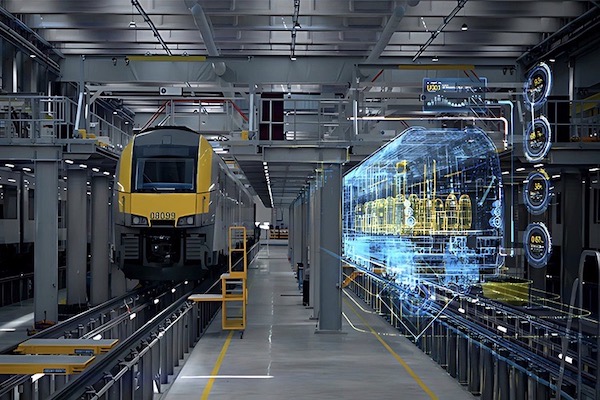Published on the 14/08/2025 | Written by Heather Wright

Getting practical on building AI maturity…
Leaders from across asset-centric industries came together recently to discuss the emergence of AI across the industry. The conversations, facilitated by COSO, in partnership with IBM, paint a picture of the state of AI in businesses.
“There’s no such thing as an IT project. Everything is a business project, some just have an IT component.”
AI’s potential and projects in play
Anthony Cipolla, COSOL AI lead, says there are many exciting case studies emerging across asset-centric industries in Australia and Asia Pacific.
“Some of our customers in transport and logistics are doing some really interesting things at the moment,” he says.
“We know technology leaders who are leaning into robotics, automation and AI to manage how equipment, resources and people move around on their sites. They’re also looking to use AI to improve workflows and rosters for staff, there’s training and career development use cases, and tools to optimise space for greater utility; there’s a lot of potential.”
Cipolla says there are also great applications in other site-centric cases and some teams are using computer vision for stockpile assessment or worksite safety and compliance.
For Rolf Samonte, head of ICT & Cyber Security for Metro Trains Sydney, enabling the AI opportunity for line maintenance has been a focus. The company, which operates and maintains the Sydney Metro M1 Northwest & Bankstown Line, has already taken steps to plan for success.
“I think one of the key enablers for success with AI for us is that we have established the AI steering committee, headed by our CEO. The leadership buy-in is really driving the initiatives to come forward,” he says.
“Where AI could fit for us is around smarter maintenance, whether it’s using IoT and bringing that data into our ERP system and then getting the trends out of that so that we can work safer, smarter and more efficiently.”
Alinta Energy’s Chris Pratt, general manager for Energy Supply Technology, pointed out that prediction and forecasting were core pillars of an energy utility’s work to ensure grids functioned properly. This is a space where data is fundamental and AI’s potential is high.
“It all comes down to prediction,” he says. “What is our demand going to be at five o’clock tomorrow, when everyone comes home? What’s the weather forecast going to be at five o’clock. What’s the price of the energy market going to be?”
Alinta is using machine learning in the trading space to understand and determine demand. “We can also harvest the data we have available to extract better information, which results in better outcomes for industry.”
Being able to predict demand can enable a generator to be turned on half an hour earlier, or a cheaper generator put on, resulting in lower overall prices, Pratt says.
“There is also technology we are rolling out now where a customer will call up, and AI will be able to identify that customer and what they might be calling about for the call centre operator, providing faster answers to customers.”
Fiona Love, general manager for Workforce Development at the Australasian Railway Association, was bullish about the impact AI would have on asset management. Love sees optimisation potential in rostering and other areas to drive efficiencies on site and, in particular, improve conditions and bolster the workforce.
“Clearly asset management maintenance is where AI can play a huge role,” she says. “One area I think about is that we want to have a much more diverse workforce. There are of course shortages in talent we’re dealing with, whether it’s in design, construction, operations or maintenance.
“However, the way rosters are currently designed means they will never work for a lot of women out there. AI can potentially help us a lot with some of those factors, because you can bring a lot of non-linear, social, emotional lifestyle factors into an AI model to help it work through.”
Prominent challenges
Another challenge the roundtable group acknowledged was resistance to change. While not exclusive to mining, this barrier to transformation can be particularly strong where big, high-value operators with long legacies are laser-focused on their core operations. Mining is, however, expected to experience more transformation as new generations of workers move into the sector.
In utilities, Alinta Energy’s Pratt highlighted regulatory constraints as another challenge when trying to unlock insights through modern AI solutions.
“We’re subject to the security standards of critical infrastructure, so governments are very concerned about keeping the lights on and we ensure that components don’t get too cold or too hot. We take risk across operations and security seriously,” he said.
“We have a lot of obligations to our clients, we go through a lot of audits and have a lot of security, there are a lot of regulations around what we can and can’t do. For example, we can’t just go and buy an off the shelf AI solution. We have to put a lot of checks and balances and guardrails in place. That can have the effect of slowing a company down with respect to innovating.”
The group also highlighted the cybersecurity implications of AI.
“From a technology leadership standpoint, cybersecurity can present one of the most significant initial hurdles,” Cipolla said.
“As organisations embark on new initiatives, it’s crucial that they create secure boundaries and operate within protected environments. This ensures that sensitive information, whether it’s proprietary data or financial instruments, remains fully safeguarded.
“The foundation must be solid governance structures, comprehensive policies, and robust frameworks established from the outset.”
David Small, business unit executive for IBM, which develops the Maximo asset management solution, said stability and software security was often a point of conjecture between the desire to benefit from the latest technologies, including AI.
He notes there can be some resistance to upgrading among customers who have a stable version of their software, have worked with it, configured it and pushed the envelope with it, there can be some resistance to upgrading.
“While customers do want the latest and greatest and the AI that comes with it, there can be reservations from a stability point of view. When it is one of the core systems that’s running a business, and it’s operating quite well and stable, there is often apprehension among customers when weighing whether they should upgrade now to gain the benefits of the added AI tools and the latest version of the software vs continuing with the existing stable version.”
AI coding, literacy, and AI shyness
Event attendees also touched on literacy, and were conscientious about whether less experienced developers could properly evaluate what constituted good code once the AI does most of the heavy lifting.
“One of the challenges with AI is understanding AI and what we actually can do with it,” Pratt says. “I sometimes feel like it’s a hammer in search of the nail, and many seem to believe it can solve all of their problems very easily.”
He also pointed out that this literacy combined with the still early days of AI adoption also raises questions about whether it’s OK to use AI.
“Because AI is still new, the rules of how to use it and when are still being tested across all industries.”
A phenomenon, termed ‘GPT shame’ or ‘AI shaming’, refers to when businesses, employees and students use AI tools like ChatGPT to review, summarise and generate content but feel uncomfortable admitting this to their peers.
In a 2025 global study by the University of Melbourne and KPMG, 57 percent of employees admitted to hiding their use of AI tools like ChatGPT at work and presenting AI-generated content as their own, Cipolla notes.
This creates an interesting dynamic where executives might prefer not to know about widespread AI usage, even though it’s already happening across their organisations. The irony wasn’t lost on participants that while they sat discussing AI strategies, many of their teams were likely already using these tools to boost productivity.
Closing thoughts on managing change
Business transformation takes time, communication and understanding across organisations and industries. For asset-centric industries looking to walk then jog then run with AI, this means effective change management must also be one of the most important areas of focus.
This business-first view was shared by Paul Lee, IBM ANZ senior technical specialist for IBM Asset Lifecycle Management.
“There’s no such thing as an IT project. Everything is a business project, some just have an IT component,” he said.
“In the case of AI, organisations need to always be thinking about what the business problem is that they are trying to solve, or the business benefit they are trying to gain. You can explore those business cases with your technology partners to tease out the right AI implementation.”
To access more insights on AI from key asset management leaders, click here to download the whitepaper.



























